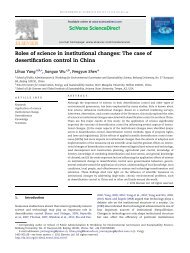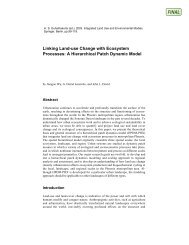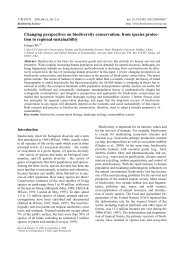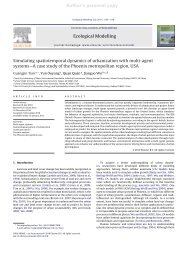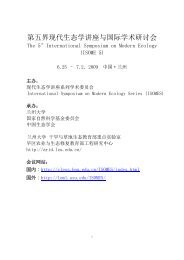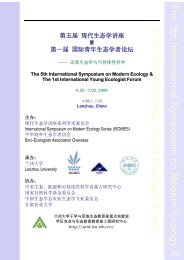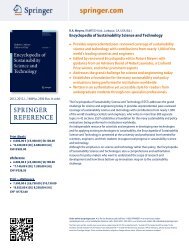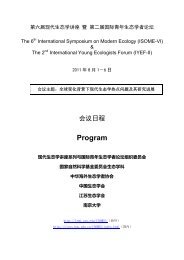Wu, J. and J. L. Vankat. 1995. Island biogeography: theory and ...
Wu, J. and J. L. Vankat. 1995. Island biogeography: theory and ...
Wu, J. and J. L. Vankat. 1995. Island biogeography: theory and ...
Create successful ePaper yourself
Turn your PDF publications into a flip-book with our unique Google optimized e-Paper software.
<strong>Wu</strong>, J. <strong>and</strong> J. L. <strong>Vankat</strong>. <strong>1995.</strong> Isl<strong>and</strong> <strong>biogeography</strong>: <strong>theory</strong> <strong>and</strong> applications. In: W. A. Nierenberg (ed),<br />
Encyclopedia of Environmental Biology. Vol. 2. pp.371-379, Academic Press, San Diego.<br />
Isl<strong>and</strong> Biogeography: Theory <strong>and</strong> Applications<br />
Jianguo <strong>Wu</strong> †<br />
Princeton University, Princeton, NJ<br />
<strong>and</strong><br />
John L. <strong>Vankat</strong><br />
Miami University, Oxford, OH<br />
I. Introduction<br />
II. The Equilibrium Theory of Isl<strong>and</strong> Biogeography<br />
III. Modifications <strong>and</strong> Extensions of the Equilibrium Theory<br />
IV. Applications of the Theory of Isl<strong>and</strong> Biogeography<br />
V. Critiques of the Theory of Isl<strong>and</strong> Biogeography<br />
VI. Concluding Remarks<br />
Glossary<br />
Bibliography<br />
Isl<strong>and</strong> <strong>biogeography</strong> is the study of pattern in<br />
the distribution of species on isl<strong>and</strong>s as<br />
influenced by ecological <strong>and</strong> evolutionary<br />
processes related to isl<strong>and</strong> characteristics such as<br />
isolation <strong>and</strong> area. The MacArthur-Wilson<br />
<strong>theory</strong> of isl<strong>and</strong> <strong>biogeography</strong> asserts that two<br />
processes, immigration <strong>and</strong> extinction, determine<br />
the species diversity of an isl<strong>and</strong>’s biota. As the<br />
number of species on the isl<strong>and</strong> increases, the<br />
immigration rate decreases <strong>and</strong> the extinction<br />
rate increases. The immigration rate decreases<br />
with isolation (distance effect), whereas the<br />
extinction rate decreases with isl<strong>and</strong> area (area<br />
effect). When the immigration <strong>and</strong> extinction<br />
rates are equal, an equilibrium of species diversity<br />
is reached. The extinction of species on an<br />
isl<strong>and</strong> <strong>and</strong> their replacement by the immigration<br />
of new species results in species turnover. The<br />
equilibrium <strong>theory</strong> of isl<strong>and</strong> <strong>biogeography</strong> has<br />
been one of the more influential concepts in<br />
modern <strong>biogeography</strong>, ecology, <strong>and</strong> evolutionary<br />
biology. It also has had a major influence on<br />
conservation biology, particularly with attempts<br />
to develop a theoretical basis for the design of<br />
† Biological Sciences Center, Desert Research Institute, University of Nevada System, P.O. Box 60220, Reno, NV<br />
89506-0220, U.S.A<br />
nature reserves. However, several aspects of the<br />
<strong>theory</strong> remain unsubstantiated, <strong>and</strong> therefore<br />
uncritical application of the equilibrium <strong>theory</strong> of<br />
isl<strong>and</strong> <strong>biogeography</strong> to nature conservation is<br />
unwarranted.<br />
I. Introduction<br />
Isl<strong>and</strong>s as ecological systems have such<br />
salient features as simple biotas <strong>and</strong> variability in<br />
isolation, shape, <strong>and</strong> size. These characteristics<br />
<strong>and</strong> their large numbers facilitate both intensive<br />
<strong>and</strong> extensive studies with the repeatability<br />
necessary for statistical validity. Since Darwin,<br />
isl<strong>and</strong>s have provided particularly important <strong>and</strong><br />
fruitful natural experimental laboratories for<br />
developing <strong>and</strong> testing hypotheses on evolution,<br />
<strong>biogeography</strong> <strong>and</strong> ecology. The <strong>theory</strong> of isl<strong>and</strong><br />
<strong>biogeography</strong> has been one of the more<br />
important products of isl<strong>and</strong> studies.<br />
Eugene G. Munroe (1948, 1953) first<br />
developed the concept of an isl<strong>and</strong> having an<br />
equilibrium species number when he examined<br />
species-area relationships in his study of the
Jianguo <strong>Wu</strong> <strong>and</strong> John L. <strong>Vankat</strong> Isl<strong>and</strong> Biogeography: Theory <strong>and</strong> Applications<br />
distribution of butterflies in the West Indies<br />
(Brown <strong>and</strong> Lomolino 1989). Unfortunately,<br />
Munroe’s ideas were unrecognized by<br />
biogeographers <strong>and</strong> ecologists until the 1980’s,<br />
partially because they appeared only as a small<br />
portion of his dissertation at Cornell University<br />
<strong>and</strong> as an abstract in the proceedings of a<br />
regional conference. Later, Frank W. Preston<br />
(1962) made a significant contribution to the<br />
early development of isl<strong>and</strong> <strong>biogeography</strong> <strong>theory</strong>.<br />
However, it was Robert H. MacArthur <strong>and</strong><br />
Edward O. Wilson (1963, 1967), working<br />
independently of Munroe <strong>and</strong> Preston, who<br />
provided a coherent, comprehensive <strong>theory</strong> with<br />
elegant mathematical models in their seminal,<br />
l<strong>and</strong>mark monograph “The Theory of Isl<strong>and</strong><br />
Biogeography.” MacArthur <strong>and</strong> Wilson’s work<br />
triggered explosive growth in the scientific<br />
literature on insular habitat studies <strong>and</strong> essentially<br />
transformed research on isl<strong>and</strong> <strong>biogeography</strong><br />
from largely descriptive works to a more<br />
quantitative <strong>and</strong> predictive new stage. Modified<br />
<strong>and</strong> extended by many others, the MacArthur-<br />
Wilson <strong>theory</strong> continues to occupy a central<br />
position in basic <strong>and</strong> applied <strong>biogeography</strong> <strong>and</strong><br />
ecology.<br />
Many studies, inspired by the <strong>theory</strong>, have<br />
been conducted not only on oceanic <strong>and</strong><br />
continental isl<strong>and</strong>s but also on a variety of other<br />
insular habitats, involving numerous different<br />
taxonomic groups of plants, animals, <strong>and</strong><br />
microbes. The <strong>theory</strong> has also had a profound<br />
impact on conservation biology in both <strong>theory</strong><br />
<strong>and</strong> practice. Although its inspirational role has<br />
been tremendous, the validity <strong>and</strong> applicability of<br />
the <strong>theory</strong> have been hotly disputed.<br />
II. The Equilibrium Theory of Isl<strong>and</strong><br />
Biogeography<br />
Species-Area Relationship<br />
A monotonic increase in the number of<br />
species with increasing isl<strong>and</strong> area (or sampling<br />
area of terrestrial communities) has long been<br />
recognized. Among various mathematical<br />
expressions for the species-area relationship, a<br />
power function of the following form has been<br />
shown to best fit observations in many cases:<br />
S = cA z<br />
(1)<br />
or log S = z log A + logc (2)<br />
Encyclopedia of Environmental Biology. Vol. 2. Page 372<br />
where S is species diversity (the number of<br />
species, i.e., species richness), A is area, <strong>and</strong> c <strong>and</strong><br />
z are positive constants. c usually reflects the<br />
effect of geographical variation on species<br />
diversity, <strong>and</strong> z has a theoretical value of 0.263<br />
<strong>and</strong> usually varies between 0.18 <strong>and</strong> 0.35. Linear<br />
regression typically has been used to estimate<br />
values for these constants.<br />
Although the above equation has been widely<br />
used, it provides little explanatory or predictive<br />
power. Thus, three hypotheses have been<br />
proposed to account for the species-area<br />
relationship: (1) the habitat diversity hypothesis<br />
by Williams (1964), (2) the passive sampling<br />
hypothesis by Connor <strong>and</strong> McCoy (1979), <strong>and</strong><br />
(3) the dynamic equilibrium hypothesis<br />
independently by Munroe (1948, 1953), Preston<br />
(1962), <strong>and</strong> MacArthur <strong>and</strong> Wilson (1963, 1967).<br />
According to the habitat diversity hypothesis,<br />
the species-area relationship results from a<br />
positive correlation existing between area <strong>and</strong><br />
habitat diversity <strong>and</strong> between habitat diversity<br />
<strong>and</strong> species diversity. In the passive sampling<br />
hypothesis, insular taxonomic groups are simply<br />
viewed as subsets or samples from larger<br />
communities. Therefore, species diversity is a<br />
function of both sampling size <strong>and</strong> intensity;<br />
Coleman et al. (1982) proposed a similar<br />
explanation that is referred to as the r<strong>and</strong>om<br />
placement hypothesis. The dynamic equilibrium<br />
hypothesis, the topic of this article, has been by<br />
far the most influential in isl<strong>and</strong> <strong>biogeography</strong><br />
<strong>and</strong> ecology.<br />
Basic Tenets <strong>and</strong> Mathematical Models of the<br />
Equilibrium Theory<br />
MacArthur <strong>and</strong> Wilson theorized that species<br />
diversity on an isl<strong>and</strong> is primarily determined by<br />
two processes: immigration <strong>and</strong> extinction. If<br />
there are a limited number of empty niches or<br />
habitats available on an isl<strong>and</strong>, the more species<br />
already there, the less likely a successful<br />
immigration of a new species <strong>and</strong> the more likely<br />
an extinction of a species already present. For a<br />
given area <strong>and</strong> degree of isolation (usually<br />
represented by distance to the isl<strong>and</strong>’s<br />
colonization source), immigration <strong>and</strong> extinction<br />
rates are expected to monotonically decrease <strong>and</strong><br />
increase, respectively, as the number of<br />
established species increases. For a given
Jianguo <strong>Wu</strong> <strong>and</strong> John L. <strong>Vankat</strong> Isl<strong>and</strong> Biogeography: Theory <strong>and</strong> Applications<br />
number of species, the immigration rate<br />
decreases with distance from the source of<br />
colonizing species because species have different<br />
dispersal abilities -- this is called the “distance<br />
effect.” On the other h<strong>and</strong>, the extinction rate<br />
will decrease with isl<strong>and</strong> area because the larger<br />
the area, the larger the species’ populations <strong>and</strong><br />
thus the smaller the probability of extinction -this<br />
is referred to as the “area effect.”<br />
When the rates of immigration <strong>and</strong> extinction<br />
are equal, the isl<strong>and</strong>’s biota is at a state of<br />
dynamic equilibrium, i.e., species diversity<br />
remains relatively constant while a compositional<br />
change of species continues. These changes in<br />
species composition result from concurrent<br />
†<br />
extinction of existing species <strong>and</strong> replacement by<br />
immigration of new species <strong>and</strong> are termed<br />
“species turnover.” The rate of change in<br />
species composition is termed turnover rate. In<br />
<strong>theory</strong>, the turnover rate at equilibrium is equal<br />
to the immigration or extinction rate (Figs. 1 <strong>and</strong><br />
2). If different groups of organisms are treated<br />
in parallel instead of collectively, it has been<br />
asserted that the turnover rate generally increases<br />
from higher to lower organisms (Schoener 1988).<br />
The mathematical description of the<br />
MacArthur-Wilson <strong>theory</strong> takes the following<br />
general form:<br />
dS(t)<br />
= I - E (3)<br />
dt<br />
where I is the immigration rate <strong>and</strong> E is the<br />
extinction rate. Assuming homogeneity,<br />
temporal consistency, <strong>and</strong> additivity of<br />
immigration <strong>and</strong> extinction rates among species,<br />
a linear relationship between the rates <strong>and</strong><br />
species diversity would be expected (Fig. 1). In<br />
other words, if all the colonizing species have<br />
similar per-species rates of immigration <strong>and</strong><br />
extinction, if these rates are constant with<br />
changing species diversity, <strong>and</strong> if species<br />
interactions are insignificant, it holds that<br />
I(s) = I 0 (S p - S(t )) (4)<br />
<strong>and</strong> E(s) = E 0 S(t) (5)<br />
where I 0 is the per-species immigration rate or<br />
immigration coefficient, E 0 is the per-species<br />
extinction rate or extinction coefficient, <strong>and</strong> S p is<br />
the total number of potential immigrants in the<br />
colonization pool. Substituting equations (4) <strong>and</strong><br />
(5) into (3) yields<br />
Encyclopedia of Environmental Biology. Vol. 2. Page 373<br />
dS(t)<br />
dt = I0Sp -(I 0 + E0 )S(t) (6)<br />
This equation gives rise to the rate of change of<br />
species diversity with respect to time. The<br />
number of species on an isl<strong>and</strong> at any time t can<br />
be calculated by integrating the differential<br />
equation. That is,<br />
I Ê<br />
0 I ˆ<br />
0<br />
S(t) = Sp -Á<br />
Sp - S(0) ˜<br />
I0 + E 0 Ë I0 + E 0 ¯<br />
(7)<br />
exp( -(I0 + E 0 )t)<br />
where S(0) is the initial number of species on an<br />
isl<strong>and</strong>.<br />
The equilibrium value of species diversity, Se ,<br />
can readily be obtained from equation (6) by<br />
setting the rates of immigration <strong>and</strong> extinction<br />
equal (i.e., I = E):<br />
Ê I0 Se = Á<br />
ˆ<br />
˜ Sp (8)<br />
Ë I0 + E0 ¯<br />
Equation (8) states that the equilibrium species<br />
diversity is only determined by per-species<br />
immigration <strong>and</strong> extinction rates <strong>and</strong> the size of<br />
species pool. The rate of change in species<br />
number can also be related to the equilibrium<br />
value as:<br />
dS(t)<br />
dt = (I0 + E0 )(Se - S(t)) (9)<br />
That is, the change rate of species diversity is<br />
proportional to the difference between the<br />
equilibrium <strong>and</strong> non-equilibrium values of<br />
species diversity. Furthermore, the change rate<br />
becomes negative for S(t) > Se , <strong>and</strong> positive for<br />
S(t) < Se . Substitution of equation (8) into (7)<br />
yields<br />
S(t) = Se - (Se - S(0))exp(-(I 0 + E0 )t ) (10)<br />
which indicates the relationship among the<br />
values of species diversity at initial, nonequilibrium,<br />
<strong>and</strong> equilibrium states. From the<br />
above equation, one can predict the time<br />
required for an isl<strong>and</strong> in disequilibrium to<br />
approach or return to the equilibrium state. This<br />
can be done by solving equation (10) for t,<br />
resulting in:<br />
ln R<br />
t = - (11)<br />
where<br />
I 0 + E 0<br />
R = S(t ) - S e<br />
S(0) - S e<br />
(12)
Jianguo <strong>Wu</strong> <strong>and</strong> John L. <strong>Vankat</strong> Isl<strong>and</strong> Biogeography: Theory <strong>and</strong> Applications<br />
R is the ratio of the departure of S(t) from<br />
equilibrium at time t to its initial deviation at t =<br />
0. The (exponential) relaxation time, Tr , is<br />
usually defined as the time required for a<br />
departure of species diversity from equilibrium to<br />
decrease to 1/e (or 36.8%) of the initial<br />
departure. That is,<br />
ln(1 / e) 1<br />
Tr = - =<br />
(13)<br />
I 0 + E 0<br />
I 0 + E 0<br />
From the above equation, 90% <strong>and</strong> 95%<br />
complete relaxations take 2.303 <strong>and</strong> 3 relaxation<br />
times, respectively.<br />
It is important to notice again that the above<br />
quantitative description is necessarily based on<br />
the assumption that I 0 <strong>and</strong> E 0 are the same for<br />
all species, are constant in time, <strong>and</strong> are<br />
unaffected by species interactions. However, in<br />
nature immigration <strong>and</strong> extinction capabilities are<br />
species specific, temporal variability exists, <strong>and</strong><br />
interactions occur among species. MacArthur<br />
<strong>and</strong> Wilson (1967) pointed out that non-linear<br />
concave curves may represent the rate-species<br />
diversity relationship more realistically than do<br />
the straight lines. They argued that species with<br />
the best colonizing abilities were most likely to<br />
establish first <strong>and</strong> that the weakest competitors<br />
would be expected to go extinct first. A gradient<br />
in species colonizing abilities would cause rapid<br />
initial drop in the overall immigration rate <strong>and</strong><br />
the combined effects of diminishing population<br />
size <strong>and</strong> increasing species interference could<br />
yield a extinction curve that was approximately<br />
exponential (Fig. 2).<br />
There also is empirical evidence that the perspecies<br />
rates of immigration <strong>and</strong> extinction tend<br />
to decrease <strong>and</strong> increase, respectively, with<br />
increasing species diversity. In particular, some<br />
studies on birds have suggested that both curves<br />
are very concave, especially the immigration<br />
curve (Gilpin <strong>and</strong> Diamond 1976). Some studies<br />
also show that the rates of immigration <strong>and</strong><br />
extinction have a roughly log-normal distribution<br />
among species, with differences ranging over<br />
many orders of magnitude (Gilpin <strong>and</strong> Diamond<br />
1981). It has also been suggested that rate curves<br />
incorporating stochastic variations would be<br />
more appropriate than deterministic lines (Strong<br />
<strong>and</strong> Rey 1982). MacArthur <strong>and</strong> Wilson (1967)<br />
commented that the modifications in shape of<br />
the two curves would not be critical, as long as<br />
the curves are monotonic.<br />
Predictions of the MacArthur-Wilson<br />
Equilibrium Theory<br />
Encyclopedia of Environmental Biology. Vol. 2. Page 374<br />
Many controversies have developed in the<br />
literature over what the original equilibrium<br />
<strong>theory</strong> of isl<strong>and</strong> <strong>biogeography</strong> does <strong>and</strong> does not<br />
predict. It is, however, generally accepted that<br />
the core of the MacArthur-Wilson <strong>theory</strong><br />
consists of the concept of species equilibrium<br />
<strong>and</strong> the postulation that the immigration <strong>and</strong><br />
extinction curves are monotonic. Major<br />
predictions based on the equilibrium <strong>theory</strong><br />
include the following: (1) there is an equilibrium<br />
for a given isl<strong>and</strong> biota that is achieved when the<br />
extinction <strong>and</strong> immigration rates are equal; (2)<br />
the immigration rate is primarily affected by the<br />
distance between the isl<strong>and</strong> <strong>and</strong> its continental<br />
colonizing source, <strong>and</strong> the extinction rate varies<br />
primarily with isl<strong>and</strong> area; (3) for a given isl<strong>and</strong>,<br />
the immigration rate decreases <strong>and</strong> the extinction<br />
rate increases with increasing number of species<br />
already on the isl<strong>and</strong>; (4) the number of species<br />
at equilibrium increases with isl<strong>and</strong> area <strong>and</strong> this<br />
increase should be faster on more remote isl<strong>and</strong>s;<br />
(5) the number of species at equilibrium<br />
decreases with isl<strong>and</strong>-continent distance <strong>and</strong> this<br />
decrease should be faster on smaller isl<strong>and</strong>s; <strong>and</strong><br />
(6) the species turnover rate at equilibrium is<br />
greater on less distant <strong>and</strong> smaller isl<strong>and</strong>s (Fig. 2).<br />
III. Modifications <strong>and</strong> Extensions of the<br />
Original Equilibrium Theory<br />
The curves of immigration <strong>and</strong> extinction<br />
rates are central to the equilibrium <strong>theory</strong> of<br />
isl<strong>and</strong> <strong>biogeography</strong>. Studies have suggested: (1)<br />
the immigration rate, at least for plants, may<br />
initially increase with increasing species diversity<br />
as the original unfavorable environmental<br />
conditions of the isl<strong>and</strong> are ameliorated by the<br />
first colonists, <strong>and</strong> (2) slight rate heterogeneity<br />
<strong>and</strong> weak species interactions may alter both<br />
concave <strong>and</strong> convex curvatures, whereas great<br />
rate heterogeneity, temporal variability, <strong>and</strong><br />
strong species interactions can produce<br />
significant changes in the rate curves such as<br />
discontinuities, non-monotonic features, etc. <strong>Wu</strong><br />
<strong>and</strong> <strong>Vankat</strong> (1991) examined the effects of
Jianguo <strong>Wu</strong> <strong>and</strong> John L. <strong>Vankat</strong> Isl<strong>and</strong> Biogeography: Theory <strong>and</strong> Applications<br />
several different sets of immigration/extinction<br />
rate-species diversity curves on the predictions of<br />
the MacArthur-Wilson <strong>theory</strong> through computer<br />
simulations. They found that different<br />
monotonic rate-species diversity curves do not<br />
affect the basic predictions of the <strong>theory</strong> of<br />
isl<strong>and</strong> <strong>biogeography</strong>; however, the level of<br />
equilibrium species diversity can be substantially<br />
affected. On the other h<strong>and</strong>, non-monotonic<br />
rate-diversity curves may result in potential<br />
multiple equilibria of species diversity.<br />
Questions about the assumption of<br />
independence between immigration <strong>and</strong><br />
extinction rates also have produced<br />
modifications in the original MacArthur-Wilson<br />
model. For example, researchers have claimed<br />
that the extinction rate of insular populations<br />
may be reduced when immigration of conspecific<br />
individuals provides demographic reinforcement<br />
<strong>and</strong> augments genetic variability of existing<br />
populations (e.g., Brown <strong>and</strong> Kodric-Brown<br />
1977; Wright 1985). This phenomenon has been<br />
referred to as the “rescue effect.” It suggests<br />
that distance directly affects not only the<br />
immigration rate but the extinction rate as well.<br />
More specifically, with greater distance the<br />
extinction rate may increase as immigration of<br />
conspecifics decreases. This may initially<br />
increase the turnover rate before its expected<br />
decrease. The rescue effect is most likely when<br />
the immigration rate is very high or at least<br />
approaches local recruitment rate; therefore, it<br />
may not occur with truly isolated isl<strong>and</strong>s.<br />
Another example of the lack of independence<br />
between immigration <strong>and</strong> extinction rates is that<br />
isl<strong>and</strong> area may affect both, at least to the degree<br />
that larger isl<strong>and</strong>s are more likely to receive<br />
immigrants than smaller ones. The phenomenon<br />
of increasing probability of immigration with<br />
isl<strong>and</strong> area has been called the “target effect”<br />
(Gilpin <strong>and</strong> Diamond 1976).<br />
Questions also have been raised about the<br />
assumption of the original MacArthur-Wilson<br />
<strong>theory</strong> that evolution rates are always much<br />
slower than colonization rates <strong>and</strong> therefore can<br />
be safely ignored. This assumption leads to the<br />
conclusion that the emergence of new species on<br />
an isl<strong>and</strong> results only from immigrations. Some<br />
studies on the isolated Hawaiian Archipelago<br />
have shown that the autochthonous speciation<br />
rate has exceeded the immigration rate <strong>and</strong>, with<br />
Encyclopedia of Environmental Biology. Vol. 2. Page 375<br />
adaptive radiation, has produced a species-area<br />
equilibrium involving a high degree of endemism<br />
(Juvik <strong>and</strong> Austring 1979). Other studies also<br />
have shown that isl<strong>and</strong> forms can evolve rather<br />
rapidly <strong>and</strong> differentiation to the subspecific level<br />
may occur in a single generation (Berry 1983).<br />
By restricting gene flow between isl<strong>and</strong>s <strong>and</strong><br />
their species pools, isolation could facilitate interisl<strong>and</strong><br />
evolutionary divergence <strong>and</strong> increase<br />
endemism. A long-term equilibrium of species<br />
diversity involving speciation, immigration, <strong>and</strong><br />
extinction has been termed the “taxon cycle;” it<br />
describes the process of ecological <strong>and</strong><br />
evolutionary diversification of species<br />
populations on isl<strong>and</strong>s (see Simberloff 1974).<br />
The original simplistic equilibrium concept<br />
has been exp<strong>and</strong>ed to include four phases of an<br />
insular species equilibrium: the noninteractive<br />
equilibrium, the interactive equilibrium, the<br />
assortative equilibrium, <strong>and</strong> the evolutionary<br />
equilibrium (Simberloff 1974; Pielou 1979;<br />
Dickerson <strong>and</strong> Robinson 1985; <strong>Wu</strong> 1989). The<br />
first, the noninteractive equilibrium, is a<br />
temporary or short-term phase that involves a<br />
balance between immigrations <strong>and</strong> extinctions<br />
occurring when species populations are thought<br />
to be too small for interspecific interactions to be<br />
significant. The second phase, the interactive<br />
equilibrium, is reached as population sizes grow<br />
<strong>and</strong> some of the less fit original colonizers are<br />
lost due to competitive exclusion. Following<br />
this, the third phase of assortative equilibrium<br />
involves a long time period of colonizations by<br />
better-adapted species <strong>and</strong> extinctions of lesseradapted<br />
species. This continual sorting of<br />
species composition, with or without change in<br />
species diversity, results in a non-r<strong>and</strong>om,<br />
coadapted set of species. The fourth phase, the<br />
evolutionary equilibrium, reflects the impact of<br />
natural selection on species diversity, as it<br />
represents the balance between the addition of<br />
species via increased species coadaptation <strong>and</strong><br />
adaptation to physical environment <strong>and</strong> the<br />
deletion of species through extinction as niches<br />
evolve to be narrower. Over geological time,<br />
evolution tends to gradually increase the<br />
equilibrial number of species -- a number which<br />
is steady over ecological time.<br />
Another development was <strong>Wu</strong> <strong>and</strong> <strong>Vankat</strong>’s<br />
(1991) quantitative synthesis of the <strong>theory</strong> of<br />
isl<strong>and</strong> <strong>biogeography</strong>. They produced a
Jianguo <strong>Wu</strong> <strong>and</strong> John L. <strong>Vankat</strong> Isl<strong>and</strong> Biogeography: Theory <strong>and</strong> Applications<br />
comprehensive system dynamics simulation<br />
model incorporating a variety of modifications<br />
<strong>and</strong> extensions, including area, distance,<br />
competition, habitat diversity, target, <strong>and</strong> rescue<br />
effects. A main purpose of their work was to<br />
provide a user- friendly simulation tool to<br />
enhance underst<strong>and</strong>ing of the internal structure<br />
<strong>and</strong> predictions of the <strong>theory</strong> when the<br />
modifications are taken into account.<br />
IV. Applications of the Theory of Isl<strong>and</strong><br />
Biogeography<br />
MacArthur <strong>and</strong> Wilson conjectured that the<br />
<strong>theory</strong> of isl<strong>and</strong> <strong>biogeography</strong> should be<br />
applicable to insular continental habitats <strong>and</strong><br />
habitat patches at various spatial scales. Since<br />
then, the <strong>theory</strong> has been applied to a variety of<br />
“habitat isl<strong>and</strong>s” such as individual plants, caves,<br />
lakes or ponds, mountain tops, microcosms, <strong>and</strong><br />
patches of terrestrial ecosystems. In fact, it was<br />
the <strong>theory</strong> of isl<strong>and</strong> <strong>biogeography</strong> that most<br />
noticeably brought scientists’ attention to spatial<br />
patchiness <strong>and</strong> the effects of habitat size <strong>and</strong><br />
isolation on ecological <strong>and</strong> evolutionary<br />
processes.<br />
The <strong>theory</strong> of isl<strong>and</strong> <strong>biogeography</strong>, therefore,<br />
has served as a conceptual framework for studies<br />
of impacts of habitat fragmentation on biological<br />
diversity <strong>and</strong> for research in conservation biology<br />
in general. It also has inspired theoretical<br />
investigations of population dynamics in<br />
heterogeneous environments <strong>and</strong>, more recently,<br />
provided an impetus to the development of the<br />
field of l<strong>and</strong>scape ecology, particularly in North<br />
America. For example, consideration of the<br />
effects of patch area <strong>and</strong> inter-patch distance has<br />
been central to both empirical <strong>and</strong> theoretical<br />
studies of the dynamics of populations <strong>and</strong> flows<br />
across l<strong>and</strong>scape mosaics. The equilibrium<br />
<strong>theory</strong> also has been adapted to help explain<br />
mass extinctions in geological time, as diversity at<br />
different taxonomic levels (species, genera, or<br />
family) is treated as the product of a dynamic<br />
equilibrium between origination <strong>and</strong> extinction.<br />
For example, the MacArthur-Wilson model was<br />
employed to explain changes in diversity of<br />
North American l<strong>and</strong> mammal genera during the<br />
past 12 million years. However, such<br />
paleobiological models have received much<br />
criticism (Benton 1987).<br />
Encyclopedia of Environmental Biology. Vol. 2. Page 376<br />
Almost from its inception, the <strong>theory</strong> of<br />
isl<strong>and</strong> <strong>biogeography</strong> has had enormous impacts<br />
on both the <strong>theory</strong> <strong>and</strong> the practice of nature<br />
conservation. Indeed, among its numerous<br />
applications, the <strong>theory</strong> finds its widest, most<br />
conspicuous, <strong>and</strong> yet most controversial usage in<br />
the design of nature reserves to maximize species<br />
diversity -- with nature reserves being perceived<br />
as isl<strong>and</strong>s in a sea of human-transformed<br />
habitats. Such applications gained tremendous<br />
momentum during the early 1970’s when general<br />
design principles based on the species-area<br />
relationship <strong>and</strong> the equilibrium <strong>theory</strong> were<br />
proposed. These principles became widely<br />
publicized in prestigious journals <strong>and</strong> books,<br />
including the “World Conservation Strategy”<br />
published by the International Union for the<br />
Conservation of Nature <strong>and</strong> Natural Resources<br />
in 1980. The so-called general design principles<br />
included: (1) a large reserve is superior to a small<br />
one; (2) a single large reserve is better than<br />
several small reserves with the same total area;<br />
(3) when two or more reserves are inevitable for<br />
some specific habitat or species, inter-reserve<br />
distance should be as short as possible; (4)<br />
corridors between reserves are recommended to<br />
increase inter-reserve immigration; <strong>and</strong> (5) a<br />
circular shape is optimal because it minimizes<br />
dispersal distances within the reserve.<br />
The relevance of these design<br />
principles/recommendations has been heavily<br />
criticized. For example, several authors have<br />
pointed out that there is little evidence of a<br />
dynamic equilibrium in continental habitat<br />
isl<strong>and</strong>s, yet the assumption of equilibrium is<br />
essential to the <strong>theory</strong> of isl<strong>and</strong> <strong>biogeography</strong>.<br />
Also, the <strong>theory</strong> itself does not directly address<br />
questions of shape, including what is optimum (if<br />
there is an optimal shape). Several researchers<br />
have reached the conclusion that the matter of<br />
shape is trivial in the design of nature reserves, if<br />
the mechanisms controlling species diversity<br />
dynamics for reserves <strong>and</strong> for isl<strong>and</strong>s are<br />
comparable. Another criticism is that while<br />
corridors between reserves certainly may increase<br />
immigration, facilitate gene flow, <strong>and</strong> reduce<br />
local extinctions through the rescue effect, the<br />
effectiveness <strong>and</strong> significance of corridors may<br />
greatly depend on their content <strong>and</strong> dimensions,<br />
inter-reserve distance, <strong>and</strong> specific species<br />
involved. Moreover, corridors may increase the
Jianguo <strong>Wu</strong> <strong>and</strong> John L. <strong>Vankat</strong> Isl<strong>and</strong> Biogeography: Theory <strong>and</strong> Applications<br />
spread of disease, disturbance, <strong>and</strong> exotic species.<br />
Hence, decisions about corridors ought to be<br />
case-specific rather than blindly follow general<br />
principles.<br />
A particularly controversial aspect of<br />
applying the MacArthur-Wilson <strong>theory</strong> to nature<br />
conservation has been whether a single large or<br />
several small reserves (SLOSS), with the same<br />
total area, would better protect species diversity.<br />
The answer to the SLOSS question depends on<br />
the slope of the species-area curve, the<br />
proportion of common species in the small<br />
reserves, <strong>and</strong> the gradient of colonizing abilities<br />
among species in the available pool (Soulé <strong>and</strong><br />
Simberloff 1986; Zimmerman <strong>and</strong> Bierregaard<br />
1986; Burgman et al. 1988). Indeed, both<br />
theoretical analysis <strong>and</strong> empirical evidence have<br />
suggested that in some circumstances several<br />
small reserves may have more species than a<br />
single large one. Several small reserves may have<br />
compensating advantages such as greater overall<br />
habitat heterogeneity, lower intra- <strong>and</strong><br />
interspecific competition, reduced spread of<br />
some diseases, disturbances, <strong>and</strong> exotic species,<br />
<strong>and</strong> more habitat for edge species. Moreover,<br />
the debate over SLOSS has overlooked the<br />
complexity of species diversity dynamics. Such<br />
factors as minimum viable population (MVP),<br />
minimum area to sustain MVP, <strong>and</strong> minimum<br />
dynamic area to maintain the ecosystem integrity<br />
must be considered in questions concerning<br />
nature conservation (Soulé <strong>and</strong> Simberloff 1986;<br />
Burgman et al. 1988; <strong>Wu</strong> 1989; Shafer 1990). In<br />
conclusion, it is generally accepted that the<br />
species-area relationship <strong>and</strong> the <strong>theory</strong> of isl<strong>and</strong><br />
<strong>biogeography</strong> are equivocal with respect to the<br />
SLOSS issue.<br />
V. Critiques of the Theory of Isl<strong>and</strong><br />
Biogeography<br />
The equilibrium <strong>theory</strong> of isl<strong>and</strong><br />
<strong>biogeography</strong>, like many other ecological models,<br />
is difficult to test. For the purpose of validation,<br />
the following necessary but not necessarily<br />
sufficient conditions have been suggested: (1) a<br />
strong species-area relationship; (2) an<br />
equilibrium state of species diversity; (3) an<br />
appreciable species turnover rate; <strong>and</strong> (4)<br />
detectable distance <strong>and</strong> area effects. Therefore, a<br />
strong species-area relationship alone neither<br />
Encyclopedia of Environmental Biology. Vol. 2. Page 377<br />
suffices to validate the equilibrium <strong>theory</strong> itself<br />
nor to warrant its application to a particular set<br />
of insular habitats. MacArthur <strong>and</strong> Wilson<br />
clearly pointed out in their original work that a<br />
species-area curve does not prove the existence<br />
of an equilibrium.<br />
Many attempts have been made to verify or<br />
falsify the MacArthur-Wilson model; however,<br />
direct experimental examinations, which would<br />
be most convincing, have been uncommon.<br />
Simberloff <strong>and</strong> Wilson (1969, 1970) designed an<br />
experimental test involving removing the fauna<br />
from a group of six small red mangrove isl<strong>and</strong>s<br />
in the Florida Bay while leaving two similar ones<br />
as controls. They concluded that their results<br />
supported the <strong>theory</strong> although the turnover rates<br />
were substantially overestimated. Another<br />
experimental test (Rey 1981) demonstrated the<br />
dynamic equilibrium <strong>and</strong> the area effect but did<br />
not clearly detect the distance effect. Other work<br />
purporting to validate the equilibrium <strong>theory</strong> has<br />
been controversial. Studies often have been<br />
insufficient or erroneous because of<br />
misunderst<strong>and</strong>ing the <strong>theory</strong> or misinterpreting<br />
the data collected. Recent work shows that the<br />
testing processes may also be confounded by<br />
artifactual ratio correlation when relative rates of<br />
immigration, extinction, <strong>and</strong> turnover are used<br />
(Schoener 1988).<br />
Since the late 1970’s, the validity of the<br />
equilibrium <strong>theory</strong> has been increasingly<br />
questioned <strong>and</strong> criticized on several grounds. In<br />
spite of an extraordinary number of studies<br />
regarding this <strong>theory</strong>, it has been frequently<br />
criticized for lack of convincing evidence to<br />
support the existence of a species equilibrium,<br />
species turnover, <strong>and</strong> area <strong>and</strong> distance effects.<br />
The <strong>theory</strong> also has been criticized for overaggregating<br />
many affecting factors into essentially<br />
two variables, area <strong>and</strong> distance, <strong>and</strong> leaving out<br />
species-specific population demographic <strong>and</strong><br />
genetic information which may provide the<br />
mechanism for species diversity dynamics.<br />
Several recent reviews concluded that the<br />
equilibrium <strong>theory</strong> of isl<strong>and</strong> <strong>biogeography</strong><br />
remains insufficiently validated <strong>and</strong> its<br />
application to nature conservation is premature<br />
(e.g., Boecklen <strong>and</strong> Gotelli 1984; Simberloff<br />
1986; Soulé <strong>and</strong> Simberloff 1986; Zimmerman<br />
<strong>and</strong> Bierregaard 1986; Burgman et al. 1988; <strong>Wu</strong><br />
1989). These criticisms have led to efforts to
Jianguo <strong>Wu</strong> <strong>and</strong> John L. <strong>Vankat</strong> Isl<strong>and</strong> Biogeography: Theory <strong>and</strong> Applications<br />
develop non-equilibrium theories of isl<strong>and</strong><br />
<strong>biogeography</strong> which emphasize the importance<br />
of such characteristics of isl<strong>and</strong> biotas as habitat<br />
heterogeneity <strong>and</strong> transient (non-equilibrium)<br />
dynamics.<br />
VI. Concluding Remarks<br />
The MacArthur <strong>and</strong> Wilson’s dynamic<br />
equilibrium <strong>theory</strong> has had revolutionary impact<br />
on isl<strong>and</strong> <strong>biogeography</strong> in particular <strong>and</strong> on<br />
<strong>biogeography</strong> in general by providing a<br />
conceptual framework <strong>and</strong> insight into the<br />
dynamics of geographical patterns of species<br />
diversity. It has been one of the more influential<br />
concepts in <strong>biogeography</strong>, ecology, <strong>and</strong><br />
evolutionary biology. However, several aspects<br />
of the equilibrium <strong>theory</strong> remain unsubstantiated,<br />
<strong>and</strong>, while it appears to hold in some specific<br />
cases, it does not in many others. Uncritical<br />
application of the <strong>theory</strong> to nature conservation<br />
is unwarranted <strong>and</strong> may lead to misleading<br />
conclusions.<br />
In general, as with other equilibrium<br />
paradigms in ecology, the equilibrium <strong>theory</strong> of<br />
isl<strong>and</strong> <strong>biogeography</strong> is being treated with<br />
increasing skepticism. Nevertheless, the criticism<br />
does not completely negate the value of the<br />
<strong>theory</strong> of isl<strong>and</strong> <strong>biogeography</strong>. Qualitative use of<br />
the <strong>theory</strong> can result in valuable contributions to<br />
studies even when its quantitative application<br />
may be invalid. More specifically, the <strong>theory</strong> was<br />
<strong>and</strong> still is important in guiding scientists in<br />
constructing conceptual frameworks for<br />
addressing relevant questions in which patchiness<br />
<strong>and</strong> isolation otherwise may not have been<br />
sufficiently emphasized or even identified. In<br />
fact, as indicated in the preface of their book,<br />
even MacArthur <strong>and</strong> Wilson did not believe that<br />
the equilibrium model would exactly fit all field<br />
observations; instead, they hoped that the <strong>theory</strong><br />
would provide stimulus <strong>and</strong> impetus for<br />
advancing “new forms of theoretical <strong>and</strong><br />
empirical studies.” In this regard, the equilibrium<br />
<strong>theory</strong> of isl<strong>and</strong> <strong>biogeography</strong> is one of the most<br />
successful theoretical developments in the<br />
history of <strong>biogeography</strong> <strong>and</strong> ecological science.<br />
Glossary<br />
Area effect The phenomenon that species<br />
extinction rate is reduced with increasing isl<strong>and</strong><br />
area.<br />
Distance effect The phenomenon that species<br />
immigration rate is reduced with increasing<br />
distance between an isl<strong>and</strong> <strong>and</strong> its continental<br />
source of colonizing species.<br />
Extinction curve The curve relating species<br />
extinction rate to the number of species already<br />
present on an isl<strong>and</strong>.<br />
Immigration curve The curve relating species<br />
immigration rate to the number of species<br />
already present on an isl<strong>and</strong>.<br />
Encyclopedia of Environmental Biology. Vol. 2. Page 378<br />
Isl<strong>and</strong> <strong>biogeography</strong> The study of pattern in<br />
the distribution of species on isl<strong>and</strong>s as<br />
influenced by ecological <strong>and</strong> evolutionary<br />
processes related to isl<strong>and</strong> characteristics such as<br />
isolation <strong>and</strong> area.<br />
Rescue effect The phenomenon that species<br />
extinction rate is reduced when immigration of<br />
conspecific individuals provides demographic<br />
reinforcement <strong>and</strong> augments genetic variability<br />
of existing populations.<br />
Species-area curve The curve relating number<br />
of species to isl<strong>and</strong> area.<br />
Species diversity Either the absolute number<br />
of species (species richness), or a measure that<br />
incorporates both the number of species <strong>and</strong><br />
their relative abundance.<br />
Species turnover Changes in species<br />
composition resulting from concurrent<br />
extinction of existing species <strong>and</strong> replacement by<br />
immigration of new species.<br />
Target effect The phenomenon that species<br />
immigration rate increases with increasing area of<br />
isl<strong>and</strong>s, when distance is constant.<br />
Bibliography<br />
Begon, M., Harper, J. L., <strong>and</strong> Townsend, C. R.<br />
(1990). “Ecology: Individuals, Populations,
Jianguo <strong>Wu</strong> <strong>and</strong> John L. <strong>Vankat</strong> Isl<strong>and</strong> Biogeography: Theory <strong>and</strong> Applications<br />
<strong>and</strong> Communities.” Second edition.<br />
Blackwell Scientific Publications, Oxford.<br />
Brown, J. H. <strong>and</strong> Lomolino, M. V. 1989.<br />
Independent discovery of the equilibrium<br />
<strong>theory</strong> of isl<strong>and</strong> <strong>biogeography</strong>. Ecology 70,<br />
1954-1959.<br />
Heaney, L. R., <strong>and</strong> Patterson, B. D. eds. (1986).<br />
“Isl<strong>and</strong> Biogeography of Mammals.”<br />
Published for the Linnean Society.<br />
Academic Press, London.<br />
MacArthur, R. H. <strong>and</strong> Wilson, E. O. 1967. “The<br />
Theory of Isl<strong>and</strong> Biogeography.” Princeton<br />
University Press, Princeton.<br />
Myers, A. A., <strong>and</strong> Giller, P. S. eds. (1988).<br />
“Analytical Biogeography: An Integrated<br />
Approach to the Study of Animal <strong>and</strong> Plant<br />
Distributions.” Chapman & Hall, London.<br />
Schoener, T. W. (1988). On testing the<br />
MacArthur-Wilson model with data on<br />
rates. Am. Nat. 131, 847-864.<br />
Shafer, C. L. (1990). “Nature Reserves: Isl<strong>and</strong><br />
Theory <strong>and</strong> Conservation Practice.”<br />
Smithsonian Institution Press, Washington.<br />
<strong>Wu</strong>, J. (1989). The <strong>theory</strong> of isl<strong>and</strong><br />
<strong>biogeography</strong>: models <strong>and</strong> applications.<br />
Chin. J. Ecol. 8(6), 34-39.<br />
<strong>Wu</strong>, J., <strong>and</strong> <strong>Vankat</strong>, J. L. (1991). A system<br />
dynamics model of isl<strong>and</strong> <strong>biogeography</strong>.<br />
Bull Math. Biol. 53(6), 911-940.<br />
Immigration or Extinction Rate<br />
T ^<br />
I<br />
- Immigration rate<br />
T<br />
S e - Number of species at equilibrium<br />
S p - Number of species in the colonization pool<br />
^ E - Extinction rate<br />
- Species turnover rate at equilibrium<br />
I E<br />
Se<br />
Sp<br />
Number of species, S<br />
Figure 1. The simplest version of the<br />
equilibrium model of isl<strong>and</strong> <strong>biogeography</strong> with<br />
linear relationships between the rates of<br />
Encyclopedia of Environmental Biology. Vol. 2. Page 379<br />
immigration <strong>and</strong> extinction (I <strong>and</strong> E,<br />
respectively) <strong>and</strong> the number of species present<br />
(S) on an isl<strong>and</strong>. These relationships assume<br />
homogeneity, temporal consistency, <strong>and</strong><br />
additivity of immigration <strong>and</strong> extinction rates<br />
among all species in the species pool. An<br />
equilibrium value of the number of species (S e ) is<br />
reached when the rate of species immigration<br />
from a colonizing pool of size S p is equal to the<br />
rate of species extinction on the isl<strong>and</strong>. Species<br />
turnover rate at equilibrium (T ^ ) is equal to the<br />
immigration or extinction rate.<br />
Immigration or Extinction Rate<br />
(near)<br />
(far)<br />
I near<br />
I<br />
far<br />
Distance Effect<br />
S'e<br />
S 0 e Sp 0<br />
S'e<br />
Se Sp<br />
(far) (near)<br />
(small) (large)<br />
Number of species<br />
(a) (b)<br />
E<br />
I<br />
Area Effect<br />
Number of species<br />
Esmall<br />
E<br />
large<br />
T<br />
^<br />
T'<br />
^<br />
T'<br />
^<br />
T<br />
^<br />
- Immigration rate Se - Number of species at equilibrium<br />
Sp - Number of species in the colonization pool<br />
T ^ I<br />
E - Extinction rate<br />
- Species turnover rate at equilibrium<br />
Fig. 2. The main tenets of the MacArthur-Wilson<br />
<strong>theory</strong> of isl<strong>and</strong> <strong>biogeography</strong>. The number of<br />
species on an isl<strong>and</strong> is determined by two<br />
processes: immigration <strong>and</strong> extinction. With an<br />
increase in the number of species on an isl<strong>and</strong>,<br />
the immigration rate (I) decreases monotonically<br />
<strong>and</strong> the extinction rate (E) increases<br />
monotonically. For a given number of species,<br />
the immigration rate is smaller for more distant<br />
isl<strong>and</strong>s (distance effect, part a), whereas the<br />
extinction rate is larger for smaller isl<strong>and</strong>s (area<br />
effect, part b). As a result, the number of species<br />
at equilibrium (S e ) is greater on larger <strong>and</strong> less<br />
distant isl<strong>and</strong>s than on smaller <strong>and</strong> more remote<br />
ones. Species turnover rate at equilibrium ( T ^ ) is<br />
greater on less distant <strong>and</strong> smaller isl<strong>and</strong>s.<br />
(Adapted from Daniel S. Simberloff 1974).<br />
Immigration or Extinction Rate<br />
(small) (large)




